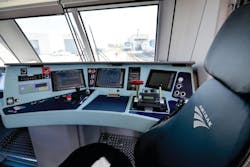When a speeding Metro-North Railroad train on the Hudson Line derailed and killed four people in the Bronx on Dec. 1, 2013, it resurrected the Spector of the fatal 2005 Metrolink derailment in Glendale, Calif., which brought on a sea change in safety in the passenger railroad industry.
After Glendale, federal officials mandated the implementation of positive train control (PTC) on all U.S. freight and passenger railroad by Dec. 31, 2015. When the Metro-North train went off the tracks, it spurred more discussions about the urgent need for PTC to be put in place.
However, with the deadline drawing nearer, it seems less likely than ever that many rail agencies across the nation will be able to hit the deadline.
“I do want to make sure that it’s clear that we’re fully committed to implementing PTC,” said Metra Executive Director and CEO Don Orseno. “But because of the challenges, quite honestly, we will not be able to hit the 2015 deadline, but we will do everything we can to come as close to that deadline as possible.”
Big needs to PTC infrastructure
Wayne Staley, executive director of PTC for the New York Metropolitan Transportation Authority (MTA) said the $428 million PTC implementation project for the Long Island Railroad and Metro North Railroad is moving forward, but it’s going to be very difficult for the agency to hit the December 2015 deadline for implementation.
Because of the size of the system, MTA has its own unique challenges in getting a system working that also will work with other operators in the region, like Amtrak and New Jersey Transit. Part of that challenge is getting radio channels for the system to operate on, which Staley said they’re currently trying to do in four counties.
Staley said the law passed in 2008 says even though you’re the owner of the PTC system, you have to ensure it can operate seamlessly by allowing everyone to communicate with each other using the same language.
“Imagine what would happen if two neighbors didn’t agree on the radio protocols and they started talking using different information,” he said. “It’s not going to work and that would not be a happy day.”
The density of trains the agencies run also create major challenges for the agency to overcome.
“There’s no such thing as an off-the-shelf PTC system,” Staley said. “I don’t care who tells you there is.”
The MTA board gave clearance for planners of the system to expedite the PTC project, but completion still isn’t expected until mid-2016.
Under the contact MTA has with Bombardier and Siemens to build the PTC system, pilot zones will be up later this year on the Metro-North between Bridgeport, Conn., and New Haven, Conn. on the New Haven Line, and between Tarrytown, N.Y., and Croton-Harmon, N.Y. on the Hudson Line.
There’s a lot of heavy lifting upfront to get this system configured, tested, validated and then get the FRA’s approval,” Staley said. “Then the next big steps will be the deployment on all of the segments.
Bruce Marcheschi, chief engineering officer for Metra, said the agency is actively doing PTC work on the system and upgrading legacy work, but there are many issues that still need to be addressed, including the development and testing of software to control onboard equipment and getting back office infrastructure in place. Once the software is developed, then the agency can test it and take care of any issues that arise.
Equipment is being placed into the system and new rail cars being supplied by Nippon Sharyo will have a PTC system already installed on them.
Funding is also an issue for the Metra project, which could cost between $235 million to $400 million when completed, which Orseno said is a significant portion of the agency’s capital projects budget.
And getting radio spectrum is also a challenge in the Chicago area, Marcheschi said, so project leaders are still working on that issue.
“The industry is limited to what they have because PTC is a new technology, so it’s hard to go out and just hire people,” he said.
Starting from scratch
Rajendra Jadhav, head of Americas for Bombardier, said when PTC was first floated by European leaders decades ago, leaders there determined to build their own communications network for PTC communication, but with the U.S. not creating such a network it does cause issues with channel availability, so Jahdav said Wi-Fi will be used in some areas to allow PTC systems to communicate. However, it would be cost prohibitive to use only Wi-Fi as an alternative, Jahdav said you need more equipment and you’re only going to get a 100 meter range and in order to get that you would need a full fiberoptic backbone.
“Some of the jobs we don’t’ want to look at because the customer expects you to do all of the work, but for a contractor, it’s not our job to go looking for licenses and working with every municipality in the area and every telecommunications company,” Jadhav said. “Sometimes it becomes imperative for a systems integrator to take on all that risk.”
John Paljug, president of Siemens rail automation, said PTC implementation for transit rail has matured a lot in recent years, so the time of implementation of a system can be done relatively quickly, however, it’s still a pretty new concept for freight rail systems.
“For freight, this is a relatively unknown new development in this technology, but I think there appears to be a lot of momentum and execution and implementation of the systems,” he said. “However, as with any new technology, it’s never a given that all the issues will be addressed immediately.”
Because it’s so new with freight rail systems, it does cause some issues for implementing a PTC system on lines carrying both passenger and freight rail.
“It’s a significant issue because we they do mix, the ACSES system and the freight PTC system aren’t compatible or interchangeable if you will,” he said. “So, therefore, whenever the freight and transit traffic mix ACSES and freight PTC systems, you have to have one or both of the trains flip over to the other system and that’s quite an issue a number of customers.”
The December derailment of the Metro-North Hudson Line sparked a national discussion about PTC needs, however, that hasn’t translated into more federal money or leeway in getting the MTA projects done. Staley said.
“The final rules and the FRA regulation, it does carry the potential assessment of fines, so that’s always with us on anything that required under federal mandates usually there are fines potentially levied, so we’re obviously looking to avoid that and doing a good faith effort. We’re not quite there so we hope that gets taken into consideration by the time that deadline comes around at the end of 2015,” Staley said. “In regards to relief and waivers, we were made abundantly clear the FRA doesn’t have the authority to grant any waivers so that’s not in the cards. That would require some form of congressional action to open that door or tow allow a process into play that would give additional time.”
Still a positive effort
Paljug said the rail industry is really in a technology “renaissance” with initiatives like PTC and the usage of such a system can provide more than just added safety.
“Sure (safety) is kind of the focus of getting the PTC systems up and working and meeting the demand of these issues, but the railroads are looking for more operational opportunities as well and that’s really the next step,” he said. “We have a safe system and PTC is another safety system and on top of that, it’s going to provide us new technological access to information we didn’t have in the past, so what’s going on in the wayside is there’s a focus on operational optimization.”
While the PTC deadline has been a challenging for transit agencies to meet, Paljug said the initiative is helping enhance the U.S. rail system for years to come because the upgrades are providing a strong infrastructure backbone for rail lines.
“It’s interesting to have a front row seat to this,” he said. “You know, I’ve been in this industry a few years and it has been quite an exciting time because the railroads are trying new technology and the technology is moving at a pace that’s really impressive for any industry.
Jahdav said it’s a huge task to meet the 2015 deadline for PTC implementation and he expects some waivers to be given on a case-by-case basis. The December Metro-North derailment sparked further concerns about PTC needs, so he said he doesn’t expect the deadline to be pushed back completely.
“In terms of trying to implement this technology in five years, in Europe they started deployment in the early 90s and 25 years later, they’re still not even half done, so this was a very ambitious target to have everything done in four years and where do you get the resources to engineer the entire system for the whole nation,” Jahdav said. “This is a problem with the industry not being very big in terms of resources and you can’t get people off the streets and train them to be PTC engineers. Even the railroads haven’t the resources in terms of experience and skills, so this is definitely an issue.”
He added, “If you ask my humble opinion, they should’ve just looked at Europe to see what they’ve been doing because they’ve been working on it for the last 20 years”.

Joe Petrie | Associate Editor
I came to Mass Transit in 2013 after spending seven years on the daily newsbeat in southeastern Wisconsin.
Based in Milwaukee, I worked as a daily newspaper reporter with the Waukesha Freeman from 2006-2011, where I covered education, county and state government. I went on to cover courts for Patch.com, where I was the main courts reporter in the Metro Milwaukee cluster of websites.
I’ve won multiple awards during the course of my career and have covered some of the biggest political events in the past decade and have appeared on national programs.
Having covered local government and social issues, I discovered the importance of transit and the impact it can have on communities when implemented, supported and funded.





